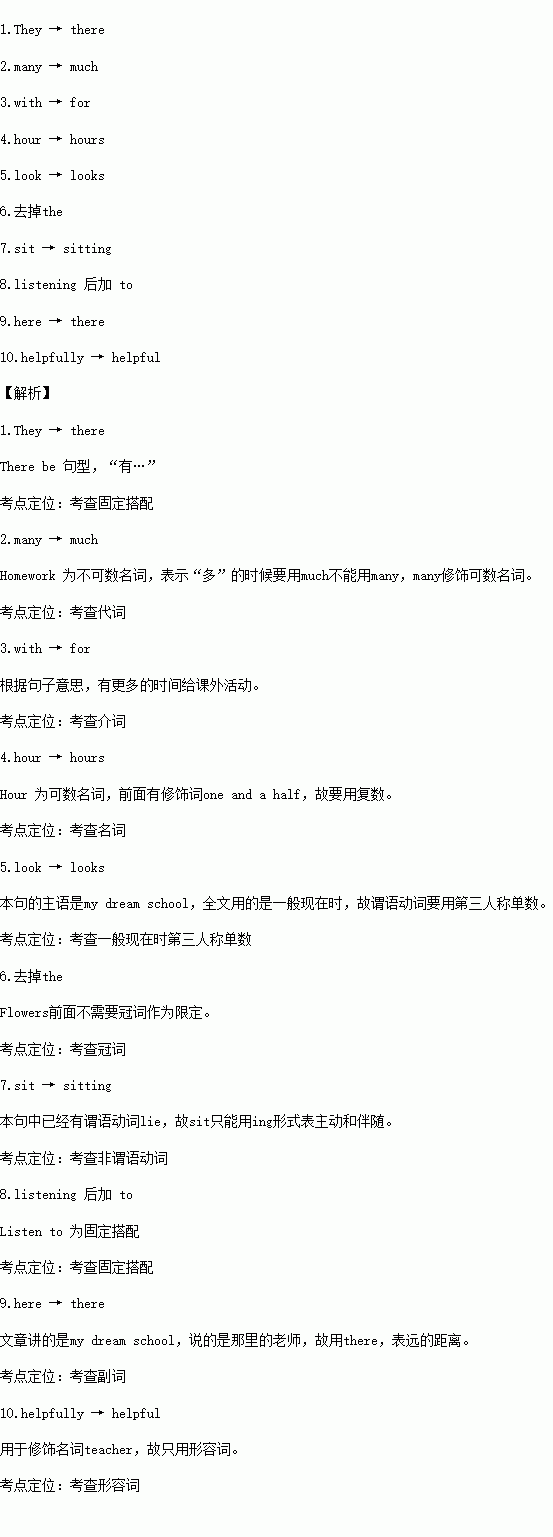ĚâÄżÄÚČÝ
śĚÎÄ¸Ä´íŁ¨š˛1ĐĄĚ⣊
źŮś¨Ó˘ÓďżÎÉĎŔĎĘŚŇŞÇóÍŹ×ŔÖŽźä˝ťťťĐ޸Ä×÷ÎÄŁŹÇëÄăĐ޸ÄÄăÍŹ×ŔĐ´ľÄŇÔĎÂ×÷ÎÄĄŁÎÄÖĐš˛ÓĐ10´Ś´íÎóŁŹĂżžäÖĐ×îśŕÓĐÁ˝´ŚĄŁ´íÎóÉćź°Ňť¸öľĽ´ĘľÄÔöźÓĄ˘ÉžłýťňĐ޸ĥŁ
ÔöźÓŁşÔÚČą´Ę´ŚźÓŇť¸öŠ×ÖˇűşĹ(ŚŤ)ŁŹ˛˘ÔÚĆäĎÂĂćĐ´łö¸ĂźÓľÄ´ĘĄŁ
ÉžłýŁş°ŃśŕÓŕľÄ´ĘÓĂĐąĎß(ŁÜ)ťŽľôĄŁ
Đ޸ģşÔÚ´íľÄ´ĘĎÂťŽŇťşáĎߣŹ˛˘ÔڸôĘĎÂĂćĐ´łöĐ޸ĺóľÄ´ĘĄŁ
עŇ⣺
1ŁŽĂż´Ś´íÎóź°ĆäĐ޸Ğů˝öĎŢŇť´ĘŁť
2ŁŽÖťÔĘĐíĐ޸Ä10´ŚŁŹśŕŐß(´ÓľÚ11´ŚĆđ)˛ťźĆˇÖĄŁ
My dream school starts at 8:30 aŁŽm and ends at 3:30 pŁŽmŁŽThey are three lessons in the morning and two in the afternoonŁŽWe didnĄŻt need to do so many homeworkŁŽTherefore , we have more time with after-school activitiesŁŽFor example, we can do reading for one and a half hour and take exercise for one hour every dayŁŽ
My dream school look like a big gardenŁŽThere are all kinds of the flowers and trees around the Classroom buildingsŁŽWe can lie on the grass for a rest, sit by the lake and listening musicŁŽThe teachers here are kind and helpfullyŁŽThey are not only our teachers but also our friends.
 ѧÁˇżěłľľŔżÚËăĐÄËăËŮËăĚěĚěÁˇĎľÁĐ´đ°¸
ѧÁˇżěłľľŔżÚËăĐÄËăËŮËăĚěĚěÁˇĎľÁĐ´đ°¸
